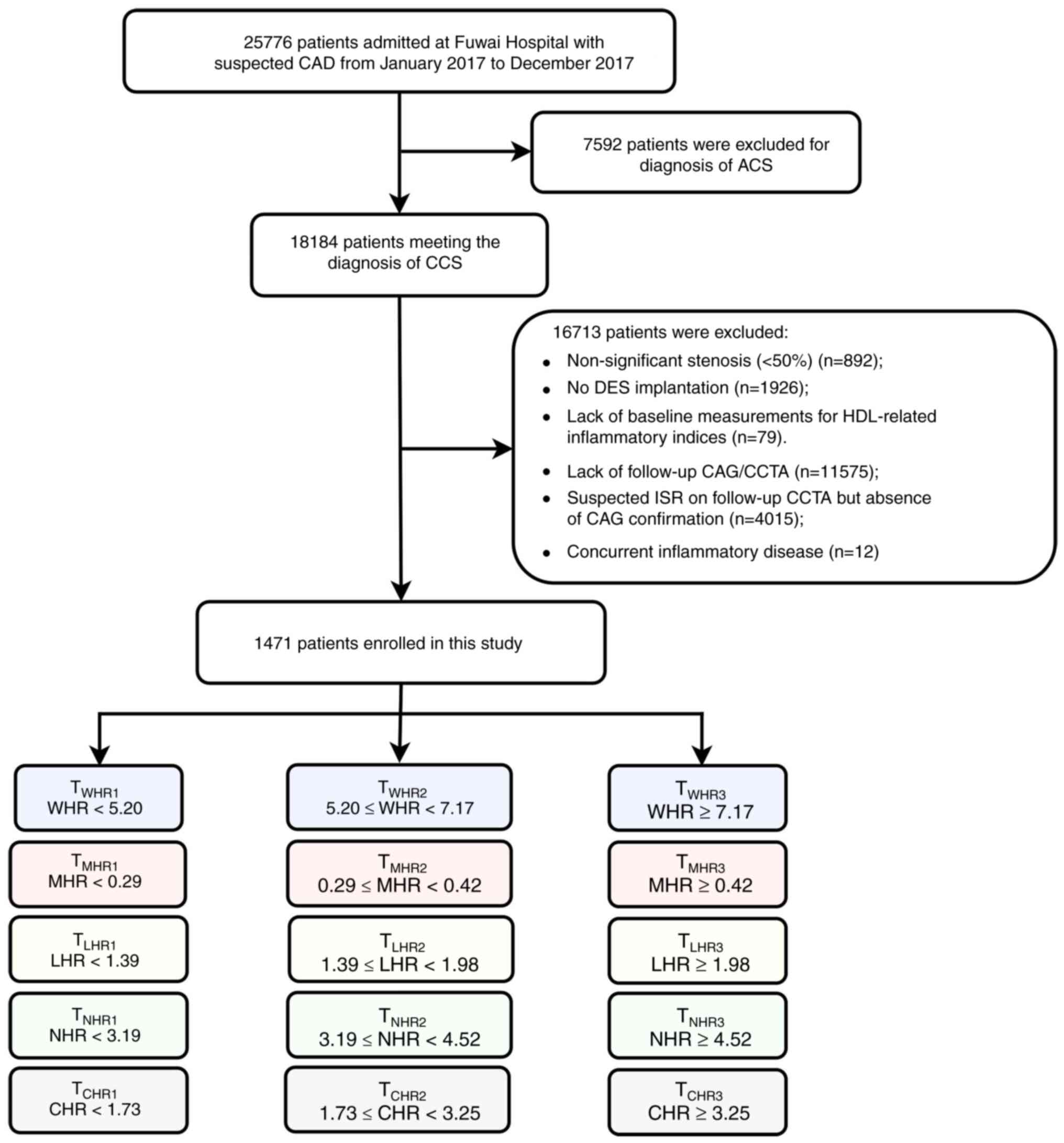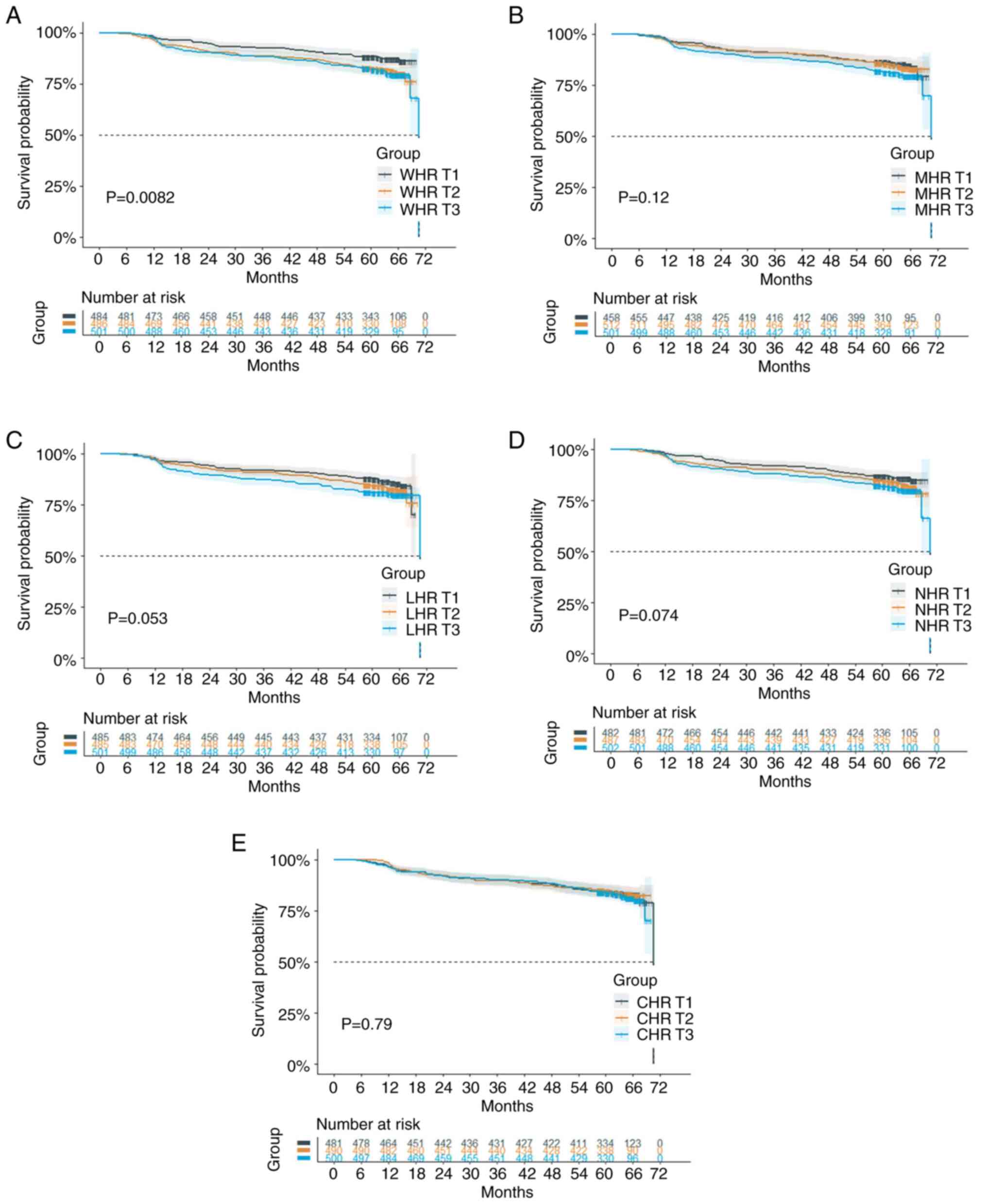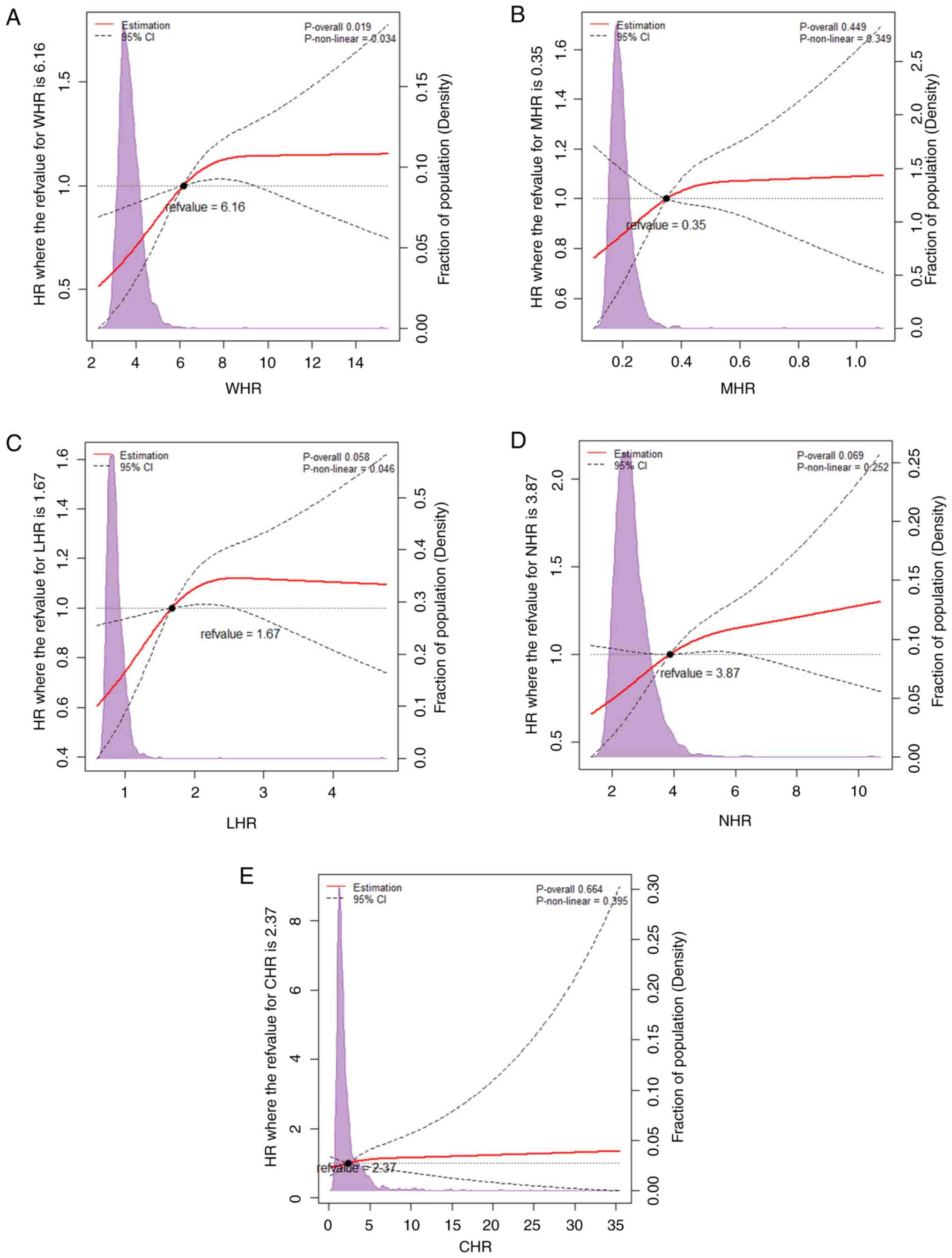|
1
|
Lawton JS, Tamis-Holland JE, Bangalore S,
Bates ER, Beckie TM, Bischoff JM, Bittl JA, Cohen MG, DiMaio JM,
Don CW, et al: 2021 ACC/AHA/SCAI guideline for coronary artery
revascularization: A report of the American college of
cardiology/American heart association joint committee on clinical
practice guidelines. Circulation. 145:e18–e114. 2022.PubMed/NCBI View Article : Google Scholar
|
|
2
|
Maron DJ, Hochman JS, Reynolds HR,
Bangalore S, O'Brien SM, Boden WE, Chaitman BR, Senior R,
López-Sendón J, Alexander KP, et al: Initial invasive or
conservative strategy for stable coronary disease. N Engl J Med.
382:1395–1407. 2020.PubMed/NCBI View Article : Google Scholar
|
|
3
|
Alfonso F, Coughlan JJ, Giacoppo D,
Kastrati A and Byrne RA: Management of in-stent restenosis.
EuroIntervention. 18:e103–e123. 2022.PubMed/NCBI View Article : Google Scholar
|
|
4
|
Shlofmitz E, Iantorno M and Waksman R:
Restenosis of drug-eluting stents: A new classification system
based on disease mechanism to guide treatment and state-of-the-art
review. Circ Cardiovasc Interv. 12(e007023)2019.PubMed/NCBI View Article : Google Scholar
|
|
5
|
The Writing Committee of the Report on
Cardiovascular Health and Diseases in China. Report on
cardiovascular health and diseases in China 2021: An updated
summary. Chin Circ J. 37:553–578. 2022.PubMed/NCBI View Article : Google Scholar
|
|
6
|
Pelliccia F, Zimarino M, Niccoli G,
Morrone D, De Luca G, Miraldi F and De Caterina R: In-stent
restenosis after percutaneous coronary intervention: Emerging
knowledge on biological pathways. Eur Heart J Open.
3(oead083)2023.PubMed/NCBI View Article : Google Scholar
|
|
7
|
Clare J, Ganly J, Bursill CA, Sumer H,
Kingshott P and de Haan JB: The mechanisms of restenosis and
relevance to next generation stent design. Biomolecules.
12(430)2022.PubMed/NCBI View Article : Google Scholar
|
|
8
|
Niccoli G, Montone RA, Ferrante G and Crea
F: The evolving role of inflammatory biomarkers in risk assessment
after stent implantation. J Am Coll Cardiol. 56:1783–1793.
2010.PubMed/NCBI View Article : Google Scholar
|
|
9
|
Gabbasov Z, Kozlov S, Melnikov I, Byazrova
S, Saburova O, Prokofieva L, Caprnda M, Curilla E, Gaspar L,
Rodrigo L, et al: Novel biomarkers for coronary restenosis
occurrence after drug-eluting stent implantation in patients with
diabetes having stable coronary artery disease. Clin Appl Thromb
Hemost. 24:1308–1314. 2018.PubMed/NCBI View Article : Google Scholar
|
|
10
|
Pan Y, Zhang J, Wu TT, Hou XG, Yang Y, Ma
X, Ma YT, Zheng YY and Xie X: Baseline white blood cell
count-to-apolipoprotein A1 ratio as a novel predictor of long-term
adverse outcomes in patients who underwent percutaneous coronary
intervention: A retrospective cohort study. Lipids Health Dis.
19(43)2020.PubMed/NCBI View Article : Google Scholar
|
|
11
|
Catapano AL, Pirillo A, Bonacina F and
Norata GD: HDL in innate and adaptive immunity. Cardiovasc Res.
103:372–383. 2014.PubMed/NCBI View Article : Google Scholar
|
|
12
|
Çiçek G, Kundi H, Bozbay M, Yayla C and
Uyarel H: The relationship between admission monocyte HDL-C ratio
with short-term and long-term mortality among STEMI patients
treated with successful primary PCI. Coron Artery Dis. 27:176–184.
2016.PubMed/NCBI View Article : Google Scholar
|
|
13
|
Huang JB, Chen YS, Ji HY, Xie WM, Jiang J,
Ran LS, Zhang CT and Quan XQ: Neutrophil to high-density
lipoprotein ratio has a superior prognostic value in elderly
patients with acute myocardial infarction: A comparison study.
Lipids Health Dis. 19(59)2020.PubMed/NCBI View Article : Google Scholar
|
|
14
|
Wu TT, Zheng YY, Xiu WJ, Wang WR, Xun YL,
Ma YY, Kadir P, Pan Y, Ma YT and Xie X: White blood cell counts to
high-density lipoprotein cholesterol ratio, as a novel predictor of
long-term adverse outcomes in patients after percutaneous coronary
intervention: A retrospective cohort study. Front Cardiovasc Med.
8(616896)2021.PubMed/NCBI View Article : Google Scholar
|
|
15
|
Guo X, Shen R, Yan S, Su Y and Ma L:
Triglyceride-glucose index for predicting repeat revascularization
and in-stent restenosis in patients with chronic coronary syndrome
undergoing percutaneous coronary intervention. Cardiovasc Diabetol.
22(43)2023.PubMed/NCBI View Article : Google Scholar
|
|
16
|
Knuuti J, Wijns W, Saraste A, Capodanno D,
Barbato E, Funck-Brentano C, Prescott E, Storey RF, Deaton C,
Cuisset T, et al: 2019 ESC guidelines for the diagnosis and
management of chronic coronary syndromes. Eur Heart J. 41:407–477.
2020.PubMed/NCBI View Article : Google Scholar
|
|
17
|
Ma YC, Zuo L, Chen JH, Luo Q, Yu XQ, Li Y,
Xu JS, Huang SM, Wang LN, Huang W, et al: Modified glomerular
filtration rate estimating equation for Chinese patients with
chronic kidney disease. J Am Soc Nephrol. 17:2937–2944.
2006.PubMed/NCBI View Article : Google Scholar
|
|
18
|
Shah AD, Bartlett JW, Carpenter J,
Nicholas O and Hemingway H: Comparison of random forest and
parametric imputation models for imputing missing data using MICE:
A CALIBER study. Am J Epidemiol. 179:764–774. 2014.PubMed/NCBI View Article : Google Scholar
|
|
19
|
Govindarajulu US, Spiegelman D, Thurston
SW, Ganguli B and Eisen EA: Comparing smoothing techniques in Cox
models for exposure-response relationships. Stat Med. 26:3735–3752.
2007.PubMed/NCBI View
Article : Google Scholar
|
|
20
|
Johannesen CDL, Langsted A, Mortensen MB
and Nordestgaard BG: Association between low density lipoprotein
and all cause and cause specific mortality in Denmark: Prospective
cohort study. BMJ. 371(m4266)2020.PubMed/NCBI View Article : Google Scholar
|
|
21
|
R Core Team: R: A language and environment
for statistical computing. R Foundation for Statistical Computing,
Vienna, Austria, 2022. URL: https://www.R-project.org/.
|
|
22
|
Borovac JA, D'Amario D, Vergallo R, Porto
I, Bisignani A, Galli M, Annibali G, Montone RA, Leone AM, Niccoli
G and Crea F: Neoatherosclerosis after drug-eluting stent
implantation: A novel clinical and therapeutic challenge. Eur Heart
J Cardiovasc Pharmacother. 5:105–116. 2019.PubMed/NCBI View Article : Google Scholar
|
|
23
|
Pinheiro LFM, Garzon S, Mariani J Jr,
Prado GFA, Caixeta AM, Almeida BO and Lemos PA: Inflammatory
phenotype by OCT coronary imaging: Specific features among de novo
lesions, in-stent neointima, and in-stent neo-atherosclerosis. Arq
Bras Cardiol. 119:931–937. 2022.PubMed/NCBI View Article : Google Scholar : (In English,
Portuguese).
|
|
24
|
Pérez-Morga D, Vanhollebeke B,
Paturiaux-Hanocq F, Nolan DP, Lins L, Homblé F, Vanhamme L, Tebabi
P, Pays A, Poelvoorde P, et al: Apolipoprotein L-I promotes
trypanosome lysis by forming pores in lysosomal membranes. Science.
309:469–472. 2005.PubMed/NCBI View Article : Google Scholar
|
|
25
|
Madsen CM, Varbo A, Tybjærg-Hansen A,
Frikke-Schmidt R and Nordestgaard BG: U-shaped relationship of HDL
and risk of infectious disease: Two prospective population-based
cohort studies. Eur Heart J. 39:1181–1190. 2018.PubMed/NCBI View Article : Google Scholar
|
|
26
|
Madsen CM, Varbo A and Nordestgaard BG:
Low HDL cholesterol and high risk of autoimmune disease: Two
population-based cohort studies including 117341 individuals. Clin
Chem. 65:644–652. 2019.PubMed/NCBI View Article : Google Scholar
|
|
27
|
Avci II, Sahin I, Gungor B, Karatas MB,
Ozcan KS, Canga Y, Keskin M, Hayiroglu MI, Karadeniz FO and Sungur
A: Association of monocyte to high-density lipoprotein ratio with
bare-metal stent restenosis in STEMI patients treated with primary
PCI. North Clin Istanb. 6:393–400. 2018.PubMed/NCBI View Article : Google Scholar
|
|
28
|
Yilmaz S, Akboga MK, Sen F, Balcı KG, Aras
D, Temizhan A and Aydogdu S: Usefulness of the
monocyte-to-high-density lipoprotein cholesterol ratio to predict
bare metal stent restenosis. Biomark Med. 10:959–966.
2016.PubMed/NCBI View Article : Google Scholar
|
|
29
|
Nan J, Meng S, Hu H, Jia R, Chen C, Peng J
and Jin Z: The predictive value of monocyte count to high-density
lipoprotein cholesterol ratio in restenosis after drug-eluting
stent implantation. Int J Gen Med. 13:1255–1263. 2020.PubMed/NCBI View Article : Google Scholar
|
|
30
|
Tok D, Turak O, Yayla Ç, Ozcan F, Tok D
and Çağlı K: Monocyte to HDL ratio in prediction of BMS restenosis
in subjects with stable and unstable angina pectoris. Biomark Med.
10:853–860. 2016.PubMed/NCBI View Article : Google Scholar
|
|
31
|
Ingersoll MA, Platt AM, Potteaux S and
Randolph GJ: Monocyte trafficking in acute and chronic
inflammation. Trends Immunol. 32:470–477. 2011.PubMed/NCBI View Article : Google Scholar
|
|
32
|
Kochiadakis GE, Marketou ME, Panutsopulos
D, Arfanakis DA, Skalidis EI, Igoumenidis NE, Hamilos MI, Sourvinos
G, Chlouverakis G, Spandidos D and Vardas PE: Vascular endothelial
growth factor protein levels and gene expression in peripheral
monocytes after stenting: A randomized comparative study of
sirolimus: Eluting and bare metal stents. Eur Heart J. 29:733–740.
2008.PubMed/NCBI View Article : Google Scholar
|
|
33
|
Ko DT, Alter DA, Guo H, Koh M, Lau G,
Austin PC, Booth GL, Hogg W, Jackevicius CA, Lee DS, et al:
High-density lipoprotein cholesterol and cause-specific mortality
in individuals without previous cardiovascular conditions: The
CANHEART study. J Am Coll Cardiol. 68:2073–2083. 2016.PubMed/NCBI View Article : Google Scholar
|
|
34
|
Wilkins JT, Ning H, Stone NJ, Criqui MH,
Zhao L, Greenland P and Lloyd-Jones DM: Coronary heart disease
risks associated with high levels of HDL cholesterol. J Am Heart
Assoc. 3(e000519)2014.PubMed/NCBI View Article : Google Scholar
|
|
35
|
Frej C, Mendez AJ, Ruiz M, Castillo M,
Hughes TA, Dahlbäck B and Goldberg RB: A shift in ApoM/S1P between
HDL-particles in women with type 1 diabetes mellitus is associated
with impaired anti-inflammatory effects of the ApoM/S1P complex.
Arterioscler Thromb Vasc Biol. 37:1194–1205. 2017.PubMed/NCBI View Article : Google Scholar
|
|
36
|
Djekic S, Vekic J, Zeljkovic A,
Kotur-Stevuljevic J, Kafedzic S, Zdravkovic M, Ilic I, Hinic S,
Cerovic M, Stefanovic M, et al: HDL subclasses and the distribution
of paraoxonase-1 activity in patients with ST-segment elevation
acute myocardial infarction. Int J Mol Sci. 24(9384)2023.PubMed/NCBI View Article : Google Scholar
|
|
37
|
Rosenson RS, Brewer HB Jr, Ansell BJ,
Barter P, Chapman MJ, Heinecke JW, Kontush A, Tall AR and Webb NR:
Dysfunctional HDL and atherosclerotic cardiovascular disease. Nat
Rev Cardiol. 13:48–60. 2016.PubMed/NCBI View Article : Google Scholar
|
|
38
|
Barter PJ and Rye KA: HDL cholesterol
concentration or HDL function: Which matters? Eur Heart J.
38:2487–2489. 2017.PubMed/NCBI View Article : Google Scholar
|
|
39
|
Ouimet M, Barrett TJ and Fisher EA: HDL
and reverse cholesterol transport. Circ Res. 124:1505–1518.
2019.PubMed/NCBI View Article : Google Scholar
|
|
40
|
Adorni MP, Ronda N, Bernini F and Zimetti
F: High density lipoprotein cholesterol efflux capacity and
atherosclerosis in cardiovascular disease: Pathophysiological
aspects and pharmacological perspectives. Cells.
10(574)2021.PubMed/NCBI View Article : Google Scholar
|
|
41
|
Tall AR and Rader DJ: Trials and
tribulations of CETP inhibitors. Circ Res. 122:106–112.
2018.PubMed/NCBI View Article : Google Scholar
|












